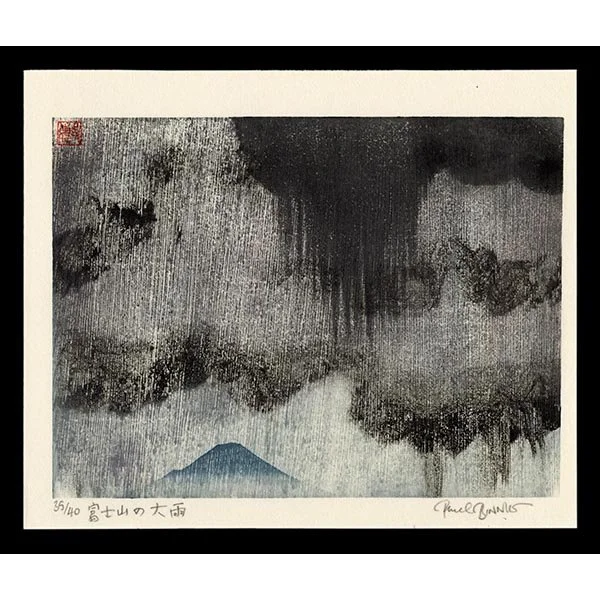Details
Paul Binnie (born 1967) is a Scottish artist who studied at Edinburgh University and College of Art from 1985 to 1990. Afterward, he lived in Paris until 1993, when he traveled to Tokyo and met the contemporary woodblock printmaker Kenji Seki, from whom he learned much about printmaking techniques. Binnie uses 20 or more blocks for some designs, cherry for the keyblock, and magnolia for the color blocks. His pigments are also used for Nihonga (Japanese-style painting) except for bero-ai (Berlin blue or Prussian blue). He prefers torinoko kôzo and nishinouchi washi for his papers. He typically begins printing an edition with about 30 to 40 prints and then finishes the edition on demand. Upon finishing, he destroys the blocks.
Binnie, who has an interest in Ukiyo-e and Shin Hanga, has designed Japanese prints in several genres, blending traditional methods with an individual modern-day style.
Words from the Binnie Studio:
“The model for this design is Binnie's favourite model, Akiko (who also modelled for Natsu and Engawa), and she is fixing her hair, and seen slightly from behind, exposing the nape of the neck, which is considered a very beautiful part of the female body by the Japanese. She wears a kimono in two tones of green, the upper part a very yellowish green known as Uguisu, the Japanese nightingale or bush-warbler, a little bird emblematic of spring and whose feathers are this shade, and the lower part of the kimono is a turquoise green-blue, reminding one perhaps of cool waters. Two plum trees are on her sleeves, and one is red, while the other is pale pink, and pink blossoms scatter the kimono. Her obi or sash is tied in the Butterfly knot of the title, and is in two distinct colours, the upper part in gold mica in a gold-leaf pattern, and the lower area has silver water swirls on deep blue. Those familiar with Japanese art of the Edo period might recognise the reference in the costume to a famous pair of screens by Ogata Korin (1658-1716) known as Red and White Plums and currently held in the Museum of Art in Atami.On one level, this new print refers back to the Edo period, but it also has close ties to the Shin-hanga (New Print) movement of the inter-war years, and in particular to the artists Ito Shinsui, Torii Kotondo, Yamakawa Shuho and so on, whom Binnie admires and collects, and whose traditional views of women engaged in everyday activities are hugely popular with print enthusiasts. In many ways, Binnie is returning to the motifs and atmosphere of the twenties and thirties in his work, and this may be in response to his close study of the prints of this period.”
Connoisseur's Note
This design was hugely popular when it was originally issued and quickly sold out. The design was used as the cover work for Binnie’s 2007 catalogue raisonne, Paul Binnie: A Dialogue with the Past. Since its inception, this design has become one of the artist’s most sought-after designs.
More prints by Paul Binnie:



